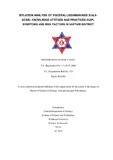Please use this identifier to cite or link to this item:
https://elibrary.tucl.edu.np/handle/123456789/1419Full metadata record
| DC Field | Value | Language |
|---|---|---|
| dc.contributor.author | Yadav, Dharmendra Kumar | |
| dc.date.accessioned | 2018-04-13T09:42:13Z | |
| dc.date.accessioned | 2021-07-23T02:41:38Z | - |
| dc.date.available | 2018-04-13T09:42:13Z | |
| dc.date.available | 2021-07-23T02:41:38Z | - |
| dc.date.issued | 2015 | |
| dc.identifier.uri | http://elibrary.tucl.edu.np/handle/123456789/1419 | - |
| dc.description.abstract | Visceral Leishmaniasis(VL) Kala-azar(KA)is a chronic infection of reticulo-endothelial system and is nearly always fatal, if left untreated. The present research was conducted in Sagarmatha Zonal Hospital Saptari district with an aim to analyze the situation of VL, VL related knowledge , attitude and practice, and risk factors of the disease. A total of 250 suspected cases were subjected to aldehyde test, rk39 test and bone marrow examination according to the laboratory diagnostic facilities available in District Hospital Saptari. The finding revealed that total 39 +ve KA cases out out from 88 examined sample 44.31% cases were found to be positive for Kala-azar. It has been found that males were affected more than females with the ratio of 5.75:4 in male and female. The age group most affected to be was found to be 15-19 years which constitutes 11.36% of total positive cases. Out of total KA cases, the distribution was found to be 16.8% among labour 22.72% among illiterate people, 28.8% among those earning <1000 Rs/month and 53.40% form the "hut" houses. Likewise, questionnaire survey among 263 respondents reveals that maximum cases were found among those respondents who have never used bed nets 69.23% sleep on ground floor (100%) and who keep cattle nearby the houses 61.53%. Regarding the knowledge of VL, none of the respondents was aware of the fact that KA is transmitted by sandfly. The Present study show that poverty, age, illiteracy, occupation, type of house, lack of knowledge regarding VL, sleeping on the ground floor without using bet nets, malnutrition, keeping cattle nearby the house and sharing the same house with cattle were responsible risk factors for the spread of KA . It was, therefore, very necessary that the people in the endemic areas should be made well conversant about the disease and vector sandfly for the prospective of sustainable management of the disease | en_US |
| dc.language.iso | en_US | en_US |
| dc.publisher | Central Department of Zoology Institute of Science and Technology Tribhuvan University Kirtipur, Kathmandu | en_US |
| dc.subject | Kala- Azar | en_US |
| dc.subject | Diagnosis | en_US |
| dc.subject | Treatment. | en_US |
| dc.title | Situation Analysis of Visceral Leishmaniasis (Kala- Azar) | en_US |
| dc.title.alternative | Knowledge Attitude and Practices (Kap), Symptoms and Risk Factors in Saptari District | en_US |
| dc.type | Thesis | en_US |
| Appears in Collections: | Zoology | |
Items in DSpace are protected by copyright, with all rights reserved, unless otherwise indicated.

